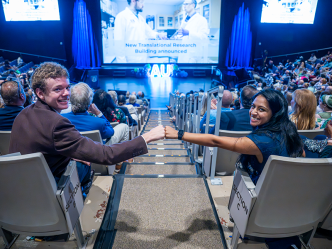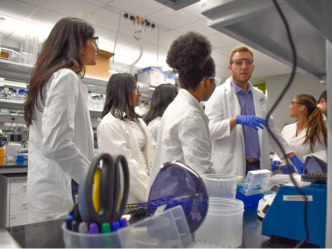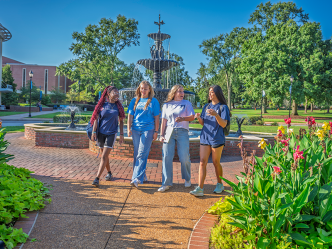Three Summerville Campus departments are working together to design a hand sanitation add-on element called Happy Hands that uses positive reinforcement to encourage good hand hygiene at Augusta University.
Lynsey Ekema, a medical illustrator in the Center for Instructional Innovation, Dr. Andy Hauger, professor in the College of Science and Mathematics, and Bill Gray, manager of educational technology in the College of Education, have designed, programmed and 3D-printed a new hand sanitizer feedback unit that they hope will encourage more frequent and consistent use of hand sanitizer.
The unit, which can be retrofitted to different hand sanitation station models, senses when a person approaches and flashes a red frowny face. If the person stops and dispenses hand sanitizer, it flashes a green smiley face.
“Happy faces are universal as a message of positivity,” Ekema said.
The purpose of Happy Hands is to grab the attention of passersby and encourage them to sanitize their hands. This deceptively simple psychological incentivization is backed by research which indicates that positive reinforcement can improve desired behaviors, such as handwashing. Augusta University Health’s Patient- and Family-Centered Care team and disease prevention staff are supporting this effort with guidance and feedback.
Ekema came across “How a Smiley Protects Health,” a study published in PLOS ONE, the journal of the Public Library of Science. It described how German and British researchers had used different feedback methods to encourage hand-hygiene, and found a simple smiley face was the most effective way to increase good behaviors — at least, temporarily. Shortly after reading about this research, Ekema was driving to the beach and passed a speed detection sign that flashed a frowny face at her.
“I immediately slowed down until I saw a green smiley face, and then I laughed because I knew exactly what they were doing with positive reinforcement,” Ekema said. “And I love to come up with creative solutions to problems by connecting people and their talents.”
So, she started sharing the original research paper across campus.The project intrigued Hauger and Gray and the three got to work. Hauger built and programmed a microcontroller, and Gray designed and 3D-printed the circuitry enclosure.
“We’re aiming for something visually engaging and functionally effective,” Gray said.
Ekema holds a certification in gamification, which is all about the science of motivation. Gamification experts take something that already exists — like a software application, or a hand-sanitation station — and use gaming techniques to motivate participation and long-term engagement.
By adding a timed behavioral element — sensing when people approach the unit, offering a frowny face to get their attention, and then changing to a smiley face when they engage in the desired behavior — they hope to inspire permanent behavioral changes.
“We hope that people will be encouraged to practice good hygiene procedures and maybe it will also brighten their day,” Hauger said.
Ekema said the units are fairly inexpensive, and they’re hoping to deploy them around campus by the time students return this fall. At under $15 each, the relatively low cost will allow them to place multiple units and to expand their inventory as time goes on. The trio is also designing a way to track their usage and study their impact on hand sanitizing behaviors.
Hauger said the project demonstrates that getting employees out of their silos and onto projects that cooperate across AU’s colleges and campuses can inspire collaboration and innovation.
Ekema agreed: “We’re proud that AU is finding innovative ways to implement safety and positive reward mechanisms.”
 Augusta University
Augusta University



